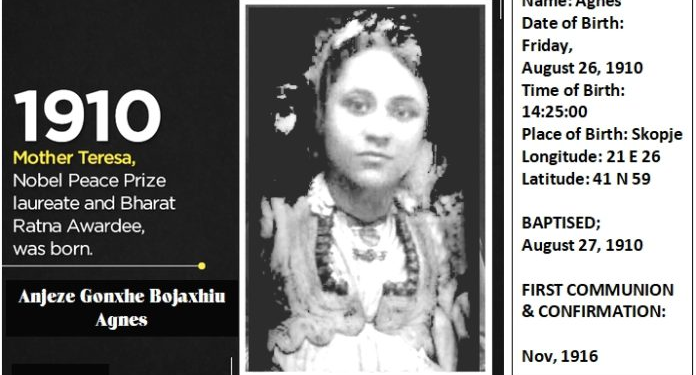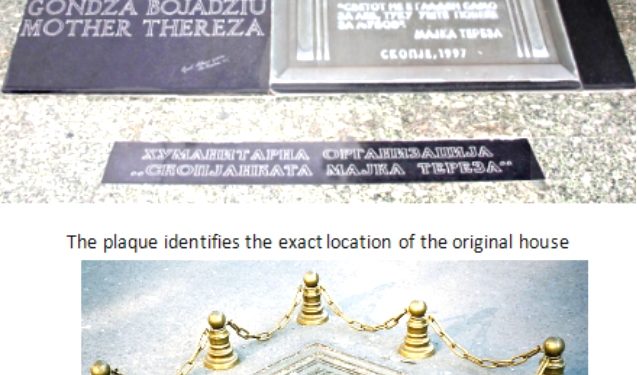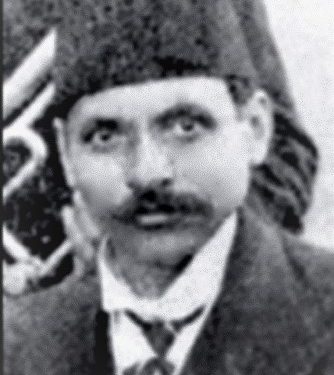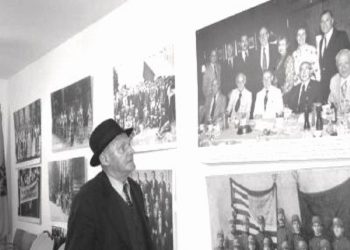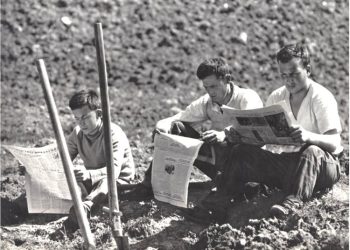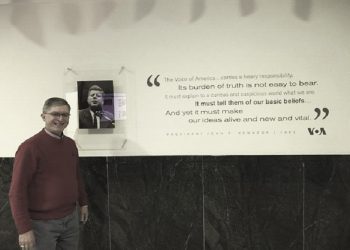From: Don Lush Gjergji, Pristina
Memories of Nikollë Bojaxhiu, on the day of his death on August 2, 1919
Kolë or Nikolë Bojaxhiu was born in Prizren in 1873, three years after the ceremonial opening and blessing of the “Our Lady Help” cathedral and five years before the League of Prizren. He was baptized in the same cathedral. His parents were Lazër Bojaxhiu, from Prizren, and Cecilia (Çilja) Bojaxhiu, originally from Shkodra.
“According to the documents found in the parish of Prizren and related to the organization and work of church companies, it turns out that Mark Bojaxhiu (Bojagia) had two sons. One was called Nrec (Nrekë), while the other was called Lazar. Lazri then had a son and he was Kola (Mother Teresa’s father) and a daughter whose name was Marija Bojaxhiu, Mother Teresa’s aunt, and who was the grandmother of Monsignor Nikollë Mini. Ndreke Bojaxhiu also had a son named Tomë Bojaxhiu”.
In the archive of the “Our Lady Helper” parish in Prizren, in 2010, the document and testament of Lazër Bojaxhiu, grandfather of Mother Teresa, son of Mark Bojaxhiu, was found, in which he wrote on behalf of the family: “The houses, land and funds of located in the city of Prizren as well as abroad, both immovable and movable assets, which in my name, as purchased property or my property, recorded in the register of public offices, as well as in private agreements … are no longer my property, but belong to the Catholic Archbishop, the Catholic Church of Prizren, who are the true and real owners of the aforementioned goods…”.
Kole Bojaxhiu was distinguished for many cultural, social, commercial and political activities, such as the builder of the Skopje Theatre, one of the builders and financiers of the railway that connected Skopje with Kosovo, especially in the gorge of Kaçanik, the only Albanian and Catholic municipal councilor of Skopje, the founder and financier of the wind orchestra “Zani i Maleve”, which paraded through the streets of Skopje on the occasion of liberation from the Turkish-Ottoman empire singing, dancing for the great victory and the high price of freedom.
He was also an ardent supporter of the struggle for freedom and independence from centuries-old Turkish-Ottoman rule, a man who supported schooling, education and civilization for his own children and others, a rare and very distinguished benefactor for the poor, especially for the Catholic Church and its charitable activities.
These activities, especially the protection of the rights and freedoms of the Albanians in the Serbo-Croatian-Slovenian Kingdom or the first or old Yugoslavia, paid for them with their lives.
To thank him for the help and support of the struggle for liberation from the centuries-old Turkish-Ottoman rule, I also have Lazri’s memory of this event: “On November 28, 1912, the heads of the Berisha, Logorec, Palucaj and Naracaj tribes, together with others, gathered to celebrate Albania’s independence. There was also Bajram Curri, a well-known patriot who fought against the Turks, Hasan Prishtina, Sabri Qytezi and many others… Baba Kolë helped the patriots materially, talked with them and gave them advice and thoughts. We had many photographs of these men. My father was very involved in politics…”
Many other sources, mainly oral, personal memories and family from Skopje and Tirana.
The main question that is asked is no longer the authenticity of this event, but the connections and interrelationships between prominent patriotic and fighting personalities and the family of Kole Bojaxhiu.
Here, then, are some reviews and clarifications that help us to better and more accurately understand this connection and cooperation. The first point is without a doubt this: Kolë Bojaxhiu was a great and devout Albanian and Catholic patriot; he had made an extraordinary contribution to the cultivation, protection and development of the Albanian language, of the Albanian school, which he had supported with flesh and blood soul and had financed it, especially the one near the “Heart of Christ” parish in Skopje.
According to the confession of the Tirana teacher Myzajen Mero, a neighbor and friend of Drane and Age Bojaxhiu, who well remembers Drane’s story about the poisoning of her husband, Kolë Bojaxhiu, due to his patriotic commitment to issues of freedom of the Albanian people, for the Albanian school near the “Heart of Christ” church, which he had founded and financed in cooperation with the Jesuit fathers, with the first teacher Ndue Vorfin.
Bashkim Zajmi, a friend of the Bojaxhiu family in Tirana, especially AvniZajmi, says that Drane and Age Bojaxhiu had two rooms and a kitchen and lived quite simply, but were very spiritual, especially “Mother Loke” – Dranja. Avni Zajmi with great respect still keeps some memories, among which stands out the soulful work “Kater Ungjijë” translated by Kostantin Kristoforidhi, published in 1872, which mother Drane often had in her hand, read, and even more so in her heart .
The household furnishings of that time, which were used by Drane and Age Bojaxhiu and which Mother Teresa had visited with many feelings and deep emotional experiences during her first visit to Albania in August 1989, are also carefully preserved.
Kolë Bojaxhiu, as is known, was a great friend and distinguished benefactor of the Catholic Church in Skopje and beyond, especially Archbishop Lazër Mjedë and the Jesuits in the “Heart of Christ” church in Skopje and its surroundings. For this very reason, he was often a guest at Kolë Bojaxhiu’s house, as a sign of respect and thanks.
Lazar Bojaxhiu said this: “The archbishop, together with the parish priest, often told him: ‘May God reward him!’… When he was at home, he often went to church, especially on Sundays and holidays, he regularly went to mass. In the family we all prayed together at night… Monsignor Lazër Mjeda often said: “Kola, may God reward you and your family, in this life and in the next, for all you have done for me, for the Church and the Albanian people”
He had also worked and cooperated continuously with many Albanian patriots in the fight for freedom and independence of the Albanian people, especially Albania, which cost him his life, because he was poisoned by Serbian (Slavic) chauvinists in Belgrade.
Kolë Bojaxhiu’s last order given to his wife Drana was a great testimony of religion and a certainty for the next life, as well as the complete release of himself and his family into the hands of God: “Don’t be sad, everything will be in order. Everything is in God’s hands… Drane, please take care of the children… From today they are in your hands… and God’s…”.
Kolë Bojaxhiu seemed to have a premonition that he would soon die, he would be killed, and according to the testimony of the neighbors where they had lived in Tirana, “Mother Loke” Drane Bojaxhiu and her daughter Age Bojaxhiu, especially Avni Zajmi’s family.
The teacher Myzajen Mero says that Drane Boajaxhiu had told her several times about the poisoning of her husband, Kolë Bojaxhiu, who was a merchant, builder, distinguished patriot, a very rich and generous man, charitable to everyone. Shi often said to Drana like this: “I will never leave my children without school… You will escort the boy Lazr to the high school in Korça, this is how I agreed with some of my friends… Sabri Qyrtezi, a family friend, escorted Lazr Boajxhiun in Korçë, where he finished high school, then followed the military academy in Graz, Austria and Turin, Italy… Later he came to Tirana for military service” Even the two daughters Agia and Gonxhja had continued their education…”
We find similar evidence in other authors who have written about Mother Teresa and her family. The testimony of the Belgian Jesuit Celestin Van Exem, the spiritual and close collaborator of Mother Teresa in Calcutta, is of special value, especially during the years of the formation of the new regular community “Missionaries of Love”.
“His father, Kolë Bojaxhiu, was a construction entrepreneur. His firm was very well known and had built the first theater in Skopje. He was a member of the city council and spoke several languages… Father Celestin Van Exemi, Mother Teresa’s spiritual leader in the early days would say that she described her father as a kind-hearted man who always helped the poor…”
The first two teachers in the primary school near the “Heart of Christ” parish were Engjëll Nocaj from Shkodra and later Ndue Vorfi. They were also the teachers and educators of Gonxhe Bojaxhiu, especially for patriotism, for the Albanian language, history, tradition and centuries-old Albanian national culture.
This is proved and proved by the photo and the inscription on the blackboard from 1922, in which Gonxhe Bojaxhiu is seen, the only one with a book in her hand, to the left of the school director Ndue Vorfi, together with Gaspër Zadrima, and the writing on the blackboard: “Albanian Catholic Primary School of Skopje. School year 1922-1923”
Ndue Vorfit, who was a teacher at the Catholic school in Skopje, originally from Gjakova, also a teacher of Gonxhe Bojaxhiu, lived with his whole family in one of the houses owned by Kola Bojaxhiu in Skopje, together with his three children: Zefin , Kola and Mary.
This once again proves the generosity and charity of the Kolë Bojaxhiu family, as well as the great wealth it had in Skopje, but also the support it gave to the school, the Albanian language and culture.
How is the “drama” of life, not the tragedy? The family of the teacher NdueVorfi, due to the Slavic persecutions against the Albanians, especially against the school, the language and the Albanian intellectuals, was forced to move to Tirana, where they were newly together with Drana and Age, who had accepted them for housing and shelter. This is how good is rewarded with good, or how God’s Providence and Christian charity work.
Dhurata Preza – Zajmi, shows that for 18 years, Drana and Agia had lived in their family and home and had been together and embodied so much that Agia called her “my daughter or daughter”, and really loved and treated her as her daughter her.
Dhurata Preza – Zajmi also shows that Agia had worked for a while at the Ministry of Popular Culture, then at the Yugoslav embassy, because in addition to Albanian and Serbian, she also spoke Italian and several other languages. After the breakdown of relations between Yugoslavia and Russia, that is, Albania, which remained loyal to Russia, she left this job and was employed as an announcer of Radio Tirana. “Well, he was suspended from work because of Mother Teresa, sometime in 1957… Then he lived by tailoring, quite simply, not to mention poverty, here and there also from some help he received from his brother Lazr from Italy. After 1967, when the religious persecution began, it was very difficult… For big parties, a table with 4 glasses and plates was laid out for ‘Mother Loke’, Agen, for me and for Gonxha… ‘Mother Loke’ never ate all the food, she said, we should leave something for angels and the poor… She was a very good woman and very soulful.. Age Bojaxhiu was very intelligent, married and received a lot of love…, mother of many children, mediator for many engagements and marriages, organizer of our many meetings and celebrations… She was a good and well-known seamstress. After the death of Mother Loke, she was very lonely, and on the day of our engagement, she suffered a heart attack and soon died,” says Dhuara Preza – Zajmi. /Memorie.al




